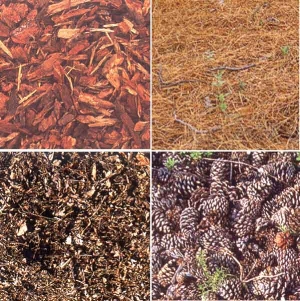Mulching your garden
Mulching is a highly beneficial landscape practice that also can result in aesthetically pleasing results. Mulches consist of organic or inorganic materials that are applied to a planting bed as a top-dressing. Typical mulches include compost, bark chips, and inert materials such as decomposed granite and river run rock.
Mulches play several important roles in a water-conserving garden. These include maintaining moisture levels in the soil, moderating soil temperatures, and inhibiting weed growth, thus reducing competition for water amongst plans. Mulches also reduce soil erosion, compaction, and water run-off. In addition, they provide a barrier between the plant and the soil, and therefore contribute to controlling soil-borne diseases that might cause plant stress. Keep in mind that aside from occasional weed control and top-dressing with additional mulch, unplanted mulched areas require no water and little routine maintenance.
In general terms, mulches can be anything that covers the soil, including ground cover plants. However, mulch usually is divided into two main categories: organic and inorganic. Organic mulches are those derived from plants and their byproducts. Examples include pine straw, which is excellent for water conservation but is flammable when extremely dry. It fades to a dull-gray-brown color with age and decomposes quickly, and therefore requires replenishment on an annual basis. Bark chips provide a more durable type of organic mulch, but also require replenishment. Leaves are an overlooked and readily available mulch, but are not as neat or uniform in appearance as pine straw and bark chips. Pinecones provide an unusual, natural-looking mulch that visually enhances the landscape. Organic mulches weather and decompose with time, and therefore are recycled back into the landscape, thus providing the soil with a natural source of nutrients. Of course, the larger the mulch chips, the longer they will take to decompose. Keep in mind that non-woody organic mulches break down quickly and therefore are best used with seasonal plantings or as temporary cover. Also keep in mind that some organic mulches easily can be blown away by strong winds.
Inorganic mulches consist of stone, rock, and synthetic products. Examples of inorganic mulches include gravel, marble chips, crushed stone, decomposed granite, river run rock, and pumice stone, which is known locally as ‘touf’ stone. Also consider shells, pebbles, and sparkling glass nuggets as mulches that add a lively touch for potted plants. Inorganic mulches generally are long lasting and are available in a wide range of colors and sizes. Unlike organic mulches, however, inorganic mulches do not decompose in the soil and therefore do not provide it with any measurable nutrients.
When deciding on the type of mulch to use, carefully consider its color. For example, dark colored mulches retain heat in the landscape, which may increase water evaporation and cause the landscape to overheat. Light colored mulches on the other hand are highly reflective, and therefore can heat up adjacent structures and result in glare. Neutral/beige tones often are the most suitable since they reduce glare, heat retention, and heat reflection problems. Ideally, mulches should be easy to apply, inexpensive, locally available, aesthetically pleasing, and should last a long time. For small areas such as planting beds, organic mulches work best. Organic mulches also are well suited to plants naturally found in moist soils since such mulches preserve moisture in the soil. For large areas, inorganic mulches are very appropriate since they are more permanent and also serve to reduce the dust coming out of the soil.
Mulch application is best done in the spring, as the soil is still damp and the summer sun has not yet dried it up. Generally, apply about 5 centimeters of mulch. However, avoid applying greater amounts because mulch retains moisture in the upper levels of the soil and therefore encourages the development of shallow plant roots. Once the mulch is in place, pull it away about 5 to 8 centimeters from the trunk of trees and shrubs to prevent wood rotting diseases. Organic mulches should be watered immediately after installation to better bind the pieces together. If the mulch is near a path, provide a raised edge or curb to prevent the mulch from spilling on to the path.
Inorganic Mulches
Organic Mulches
This article is part of a series of articles prepared by the Center for the Study of the Built Environment (CSBE) on water conserving landscapes.
For a list of mulch suppliers in Jordan, see the Suppliers list in the Water Conserving Landscapes section of the CSBE web site at www.csbe.org
Support for the CSBE project on water conserving landscapes is provided by WEPIA (Water Efficiency and Public Information for Action), a program being implemented in collaboration with the Ministry of Water and Irrigation and funded by the United States Agency for International Development (USAID).


